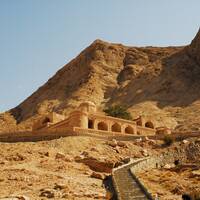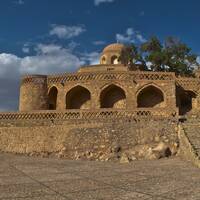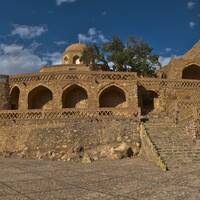Tomb of Bozorgmehr Qainin is located in the heights of Ghahestan Mountain, in the city of Qaen of South Khorasan Province. Upon visiting this site, one will wonder how all the materials have been carried for the structure to be built in this location. Even though it is not clear if this tomb belongs to the minister of Khosrow I, the Sassanid king or the minister of Ghaznavid dynasty, now his magnificent tomb has been built in an area spread over more than five hundred hectares in the foothill of Abuzar Mountain, close to the national park of Ghahestan. It is speculated that the name Abuzar attributed to the mountain, has been inspired by the first part of the name Buzarjomehr, the Arabic version of Bozorgmehr. Today his heirs are known in Qaen with the same name, Nouri Abuzari. Tomb of Bozorgmehr has been listed as a national heritage of Iran and is run under the administration of Cultural Heritage, Handicrafts and Tourism Organization of Iran in 1393 SH.
The structure of the tomb was built in the form of a Chalipa or the Persian cross in the sixth and seventh centuries AH. Materials such as stone, plaster, brick and Sarooj, a kind of water-resistant mortar, have been used to build this tomb. Belonging to the middle centuries, Tomb of Bozorgmehr has a large dome, four Iwans, and decorations such as Muqarnas, plaster stuccos, and pointed barrel vaults. The beautiful dome of this tomb can be seen from distance. Multiple restorations have made the tomb look even more attractive. There is a Mastic tree grown close to the tomb that adds to the beauty of the landscape. It is said that the tree is more than seven hundred years old. Mastic tree belongs to the desert weather and the southern ecosystem of Iran. It should not be left out that there is a tablet in the tomb that indicates the possibility of endowments. One of them is a Qanat that has been endowed to the Tomb of Bozorgmehr. Local people believe that if it was not for such actions, the tomb may have been ruined by now and the name Bozorgmehr, forgotten.



